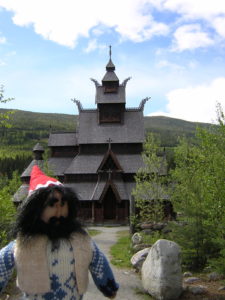
The Norwegian people have long possessed an intense love of nature and this can be seen through their rich collection of folklore and mythology. From the awe and fear of the powerful forces of the gods to the free-spirited antics of the smaller “invisible ones,” the stories have taught and entertained for centuries.
One of the groups of “invisible ones” is called nisse. Originally, the nisse were something only to be whispered about out of fear. On farms they hissed at you in the dark and were very hairy. (Actually, they often turned out to just be the barn cat!) In other parts of the country, they were regarded as mysterious spirits that lived underground. They controlled the forces of nature and, in turn, a farmer’s fortune. They were also believed to be a kind of gnome that would take on the spirit of the deceased farm owner. He would keep an eye on “his” property and make sure it was cared for. He loved all animals but favored horses. In return, he would live in the barn and demand to be well cared for and be given the best food and drink, especially around Christmas time. Ever a “trickster,” if he did not get his rommegrote with butter on Christmas Eve he was sure to make trouble and even move to another farm. There have been cases where a nisse has become so fond of the farmer and the family that he has chosen to leave his own land in order to immigrate to America with his adoptive family.
Nissen are no bigger than a child and have many names. They can also be called gord-borde, tunkall or tusse. When he is called gordvord or tunvord he is referred to as a protector. The word nisse is a love name and is derived from the name Nils.
Over the years, nisse have played an important role in helping Norwegians regain their national pride. During WWII, they even became a national symbol for patriotism. Today, they are not only characters full of Norway’s heritage, but have become irresistible little people with a red pointed hat.
Our nisse history began in 2003 when our 79 year old mother wanted to pay her own way to Norway. I suggested she make Nisse dolls and I would sell them for her. And yes, by next year, she paid her own way to travel, with us two daughters, to Norway where she got to see the house where her mother was born and also the house where her grandmother was born.